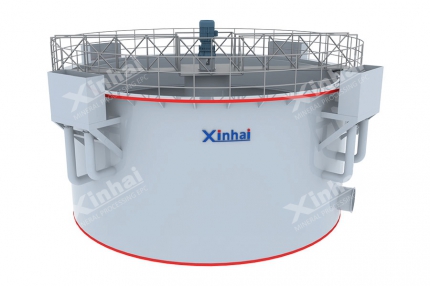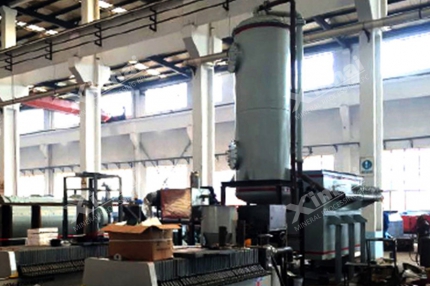Alluvial gold deposits are the gold-bearing mud-sand sedimentary minerals formed by long-term weathering in pulmonic gold deposits, which are a kind of valuable mineral. In this passage, we will introduce you the alluvial gold mining technology from the main characteristics, preparation before processing and its processing technology.
Use the table of contents below to navigate through the guide:
01The main characteristic of alluvial gold
This kind of gold minerals can be divided into bank sand gold, river sand gold, beach sand gold and riverbed sand gold. The gold content of these sand gold varies a lot, ranging from tens of milligrams per cubic meter to tens of kilograms per cubic meter. Because of the washing effect of its formation, the high-density useful minerals are gathered in the alluvial gold deposit. There are common platinum, cassiterite, magnetite, ilmenite, chromite, rutile, wolframite, scheelite besides the natural gold. The gangue minerals mainly include quartz, garnet, tourmaline, barite, mica and other minerals. The particle sizes of natural gold minerals are ranging from 0.1mm to 4mm, and with various shapes.
According to the sediment percentage, the alluvial gold can also be divided into washable type with sediment percentage less than 10%, medium washable type with sediment percentage between 10%~15%, and difficult to wash type with sediment percentage between 15%~30% and very difficult to wash type with sediment percentage more than 30%. The fine slime is mainly formed by non-metal minerals, including kaolin, montmorillonite clay, hydromica, calcite, feldspar and other fine clay minerals. The particle size of the clay minerals is usually more than 5 micron, and the content percentage is more than 3%.

02The preparation of alluvial gold mining
The preparation of alluvial gold mining includes the wet crushing, washing and wet screening. During this period, the large gangue minerals and fine silt can be discarded, which is convenient for the successive classification and gravity separation.
In this stage, the factors influencing the working efficiency includes the degree of washing of raw ore, grainsize composition of raw ore, the method of water feeding, the water consumption of 1cubic meter raw ore, the structure of crushing equipment, the residence time of raw ore in the crushing equipment, the strength of crushing and washing, etc.
03The processing stage of alluvial gold mining
In the processing stage, the processing method is usually gravity separation for alluvial gold. A combined process of gravity separation and amalgamation of mercury is sometimes used. According to the difference of equipment, it can be divided into spiral chute separation, jig separation, shaking table separation, hydrocyclone separation, spiral separator separation and so on.

(1) Spiral chute separation
As a simple gravity separator, the spiral chute has the characteristics of large capacity, high enrichment, wide granularity range and so on. The main influencing factors includes the capacity of 1 meter long chute width or 1 square meter collecting area, the slope of chute, the concentration of slurry pulp, slurry flow velocity, the cover material and its shape, the grain size composition of raw ore, the heavy sand content, washing times and so on.
(2) Jig separation
Jig separation has requirements on the particle size and content. The particle size is usually 10%-15% under 0.2mm. The raw ore should be with gold between 25-300mg in a cubic meters. Under this condition, the gold above 0.2mm can be recovered. Compared with spiral chute, jig separation has higher gold recovery rate in alluvial gold mining.
(3) Hydrocyclone separation
The hydrocyclones with cone angle of 90 or 120 degree is called processing hydrocyclone or short cone cyclone, which can be used in mineral processing. The application of this kind of hydrocyclone can receive a higher gold recovery rate and processing efficiency than jig separation and shaking table separation. In the alluvial gold mining, it can be used combined with jigs and spiral chutes in the same processing flow, as the gravity separation equipment of fine gold particles.

(4)Spiral separator separation
The spiral separator has simple structure, and small occupied area, which is easy to operate and energy saving. It can be used with jigs and spiral chutes in alluvial gold mining, to reach a higher recovery rate.
(5) Shaking table separation
Shaking table has a smaller capacity than other gravity separation equipment, while the enrichment of concentrate is higher. The shaking table separation can be divided into two types, coarse sand shaking table separation and slime shaking table separation. The coarse recovery rate is up to 98%-99%, while the slime recovery rate is between 35%-55%, which is maily used for alluvial gold mining concentrating.
The above is some information about alluvial gold mining. In the production, it is reasonable to determine the certain processing technology and equipment through the mineral processing experiment, to guarantee a good economic efficiency on the basis of a good indicators in benefication.


 marketing@ytxinhai.com
marketing@ytxinhai.com  0086 13810327080
0086 13810327080 






































































































 CHAT
CHAT MESSAGE
MESSAGE





